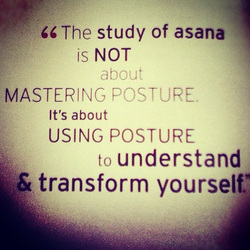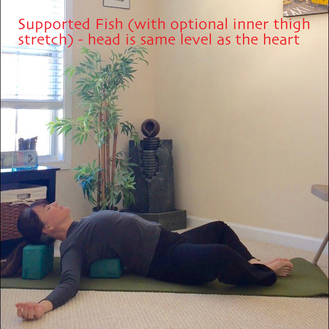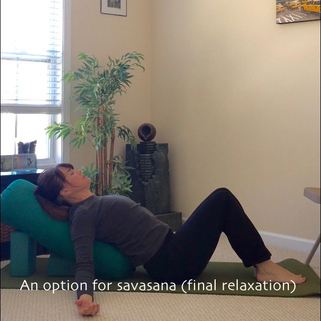|
Here are some tips for those of you who might already practice yoga but find it occasionally makes you dizzy or brings about a vertigo episode. There are some things you can do while practicing that may help you fend off the dizzy or avoid the episode. First – as with any yoga practice – stay present and really tune in to your body. If something isn’t working for you – there is NO reason to continue to do it. Practice with a lot of space around you in case you stumble or fall (near a wall is helpful). First of all, pick your classes carefully. Know that there may be days where a hatha or vinyasa yoga class is just not appropriate for you, as much as that might disappoint you. Trust me, I’ve been there! Maybe a gentle, restorative, or a deep stretch class would be better on that day. Hot yoga? I can’t imagine hot yoga working well for someone with a vestibular disorder so I would proceed with caution there, but again, if it works for you, go for it. Learn to tune in to your body and your vestibular system while practicing. Honor both every time you step on your mat. Begin to find your limits and modifications and learn to live within them, making peace with what life has given you. And celebrate with so much gratitude those days when you are well enough to do ANY practice. Modify. Modify. Modify. That’s going to be your mantra for your practice right now. For example, if you find that camel pose (ustrasana) makes you dizzy or makes the world spin (vertigo), then while the rest of the class is doing camel – you can sit in heroes pose (seated on your heels) and breathe. I don’t know of a yoga teacher that would oppose to that (you just may want to let your teacher know ahead of time that dizziness and vertigo are issues for you and that you might be modifying certain poses). For me – camel pose is fine as long as I don’t drop my head back (see picture below). I lengthen the back of my neck and keep my gaze forward. I also don’t take the full pose (hands to heels) and keep them on my lower back instead. Or maybe fish pose (matsyasana) makes you dizzy (here again it may the neck in extension that causes it). Practice supported fish instead with your head neutral (on a block) or even a bit higher than your heart to avoid getting dizzy. Many benefits…a nice heart opener, a nice stretch of the pectoral muscles, but with less risk of spinning. Anyone who has taken my yoga class knows this is my favorite pose to teach and to do! You may also notice that twisting poses cause some issues with your vestibular system. In those instances, keep your chin aligned with your chest. Turn the ribcage without turning the cervical spine (the neck). This works for seated, standing, or supine twists. In poses like triangle (trikonasana), extended side angle (parsvakonasana), and even balancing half moon (ardha chandrasana), your teacher might cue you to turn your gaze toward your top hand or toward the sky. In these poses, I notice that keeping my chin aligned with my chest (neutral neck with no twist) or even looking down toward the earth helps me to stay grounded and avoid the dizzies. Try it and see if helps you too. If going upside down makes the world go upside in the opposite direction, use the wall for your downward facing dog (adho mukha svanasana) so that your head stays at or above heart level. Put your mat by the wall ahead of time (you may have to make it a habit to get to class early to get that coveted back corner spot) and place your hands on the wall so your body and legs form a right angle for your downward facing dog. For the “vinyasa flow” you can squat down to step back into plank and do the chaturanga pushup, upward facing dog (urdhva mukha svanasana), and then push back into child’s pose (balasana). Or do cat/cow into child’s pose. So many options for you! Or during standing sequences, just skip the flow altogether. While the rest of the class is folding forward and going through the vinyasa flow – you can step forward into mountain pose (tadasana) and then step back into the next standing pose. Mountain pose is such a wonderfully grounding pose and great for those of us who have issues with the vestibular system. So more time in it is a really good thing! I had a student stop coming to class because she got dizzy in final relaxation (savasana). Savasana does not have to be fully supine to be effective. If you find that lying on the floor is NOT relaxing because it makes you dizzy, find what works. I don’t know any yoga teacher that would rather you skip class. They would much rather help you find an alternative. Just don’t skip final relaxation. In my humble opinion, it’s the most important pose of the practice. Maybe you need to keep your eyes open (just keep them soft and try to truly relax). Or place a bolster under your knees and/or a blanket under your head. Or lie on one side (your good side – many people with vertigo, especially BPPV, know what that means). Or recline on a bolster or bolster/blocks so that you are not fully supine (shown below). When getting up – take extra time. Don’t rush – taking several breaths on your good side, and then sit up very slowly, letting your head come up last. You can even do savasana seated if need be. The takeaway of this whole post is: yoga is about finding what works in YOUR body on THAT day. Don’t be bound by some idea of a perfect pose or not wanting to stand out or do something “wrong.” This is your practice and it’s supposed to be therapeutic for you. If it doesn’t feel that way – change it. Give yourself permission to honor your body (and your vestibular system).
Love and light to you!  Anyone who has ever played a game or sport with me or against me will attest to the next statement. I am a competitor. Always have been. My family is competitive. We used to shoot free throws in our driveway on a full-sized, perfectly-measured basket to decide who had to feed the dogs. When I was 6. I fed the dogs. A lot. But eventually, I became pretty good at shooting free throws and there were actually some days when my much older, basketball playing brothers or my Dad had to feed those dogs! I was a gymnast and competed for many years. I ran track (badly). I was a cheerleader and diver in high school and college. I played tennis for many years as an adult. I’ve played Scrabble and every other board game or card game with my Mom & aunts since I was about 8. I learned to play War (cards) when I was 2. And even though my parents taught my brothers and me to be good losers and to be generous to our opponents, and that doing our best was really the only thing that mattered, we still hate to lose with every cell in our being. My best friend is not competitive. She played tennis with us for a few years and, while she always played to win and was a very good player, as soon as it was over, win or lose – her mood was the same. She would laugh if she hit a bad shot and truly didn’t mind what the final score was. She was enjoying the moment. For the longest time, I didn’t get it. Part of me thought she was a little crazy for not needing the win. Another part of me was impressed that she could let things go so easily and move on. These are the kinds of people who probably don't get migraines. Now, I’m not saying that competition is a bad thing. I am an avid Braves fan, and I REALLY want them to win. Like every single game. I yell at the TV and get worked up over decisions I don't agree with and enjoy every single moment. Watching the Olympics brings countries together in a healthy competitive way. Competition can drive us and make us better. But there is a very fine line between healthy competition and competition that makes you into an irrational person . Or, even worse, a jealous person. So it’s no surprise that when I first came to yoga, I found myself looking around the room and wanting my poses to look “better” or “deeper” or “more perfect” than someone else's poses. It took me a while to understand that competition and yoga just aren't quite compatible. (Don’t get me started on the new yoga competitions popping up – that’s a blog for another day). Yoga is about being okay with where you are today. There is no perfect pose, only one that is perfect for your body in that moment. Slowly but surely, I started to understand this and started to not only really feel my body, but to actually listen to it. Our bodies talk to us all the time – we just don’t always listen. As one of my favorite teachers, Sally, always says, “Be okay with where you are, but open to possibilities.” I love that so much that you may have heard me say it in class. Thank you, Sally! Not being competitive doesn’t mean being stagnant in your practice. It’s okay to push your edge when your body gives permission and to learn new poses or strive for more flexibility, more balance, more strength, more peace of mind. But it’s the competition with others in your class or even with your own body that will work against you. So while it took me years to really let go of my competitive nature on my mat, I can honestly say I am no longer competitive during my yoga practice. I stay in my own space, eyes usually closed or a very direct drishti (gaze point), and I enjoy every pose for what is in that moment. I embrace my strengths and accept my non-strengths. I am flexible in some areas, not so much in others. I can do many poses but am physically unable to do others. Maybe yet – maybe ever. When my doctor told me that I had spondylolysis and spondylolisthesis (two very big words that just means years of gymnastics funked out my lumbar vertebrae), I was very frustrated. And when he told me not to do big backbends ever again, I felt let down by my body. Until I finally realized that doing a big backbend (or ANY pose) does not make me more of a yogi. And blaming my body makes me even less of one! So I let the big backbends go. They don't serve me any longer. In fact, they could actually hurt me, so what would be the point of pushing myself into one? I found new ways to stretch my chest muscles and open my shoulders and hip flexors. I learned to do littler backbends with enough core engagement to protect my low back. But what matters MOST to me now are the poses that serve me today. And I have to say, it’s liberating not competing with others or with my own body. I'm thankful for the poses I can do. And thankful that I used to be able to do those big backbends so that I feel more confident teaching them to those who will benefit from them. So when your brain tells you someone else is doing it better or when you find yourself judging yourself or your practice with negativity - let it go. Enjoy the journey and don’t anticipate or worry about what may come next. You may NEVER touch your toes. That arm balance may ALWAYS elude you. It may be safest for you to do chaturanga with your knees on the mat for years. Who cares?! One of the goals of yoga is to eventually take what you learn on your mat off your mat and into your everyday life. I’m still working on that part. But I’ve seen it happen on my mat so I’m hopeful. It does take time so try to be patient with yourself. I’ll try to be patient with myself too. Maybe we can encourage and learn from each other, instead of competing with each other.  So the story goes that if you throw a frog into a pot of boiling water, he will immediately jump out, saving his own life. But if you put him in room temperature water and then gradually turn up the heat, he will boil to death, not realizing he is in danger until it's too late. A morbid thought for sure and I don't think I'll test it to find out if it's true (my frog phobia might get in the way of that unnecessary experiment). But whether it's true or not, it's a great reminder about how stress affects our bodies. An immediate stressor will put you into "fight or flight" to deal with the situation immediately and effectively or to get you the heck outta there! But those stressors that come on slowly and accumulate over time are wreaking havoc in all systems of your body and you may not even notice until it’s too late. Stress is not bad, but chronic stress is. So listen to the messages your body sends you. And respond. Do whatever you can to lower your stress: pray, meditate, practice restorative yoga, play tennis, run, eat well, think positively, keep a gratitude journal, surround yourself with loving & happy people, etc. Don't wait. Please don't be the frog. (Buy the frog at http://www.prettycleverdecor.com)
When I first started practicing yoga regularly, and I mean really regularly…3-4 times a week (and well before I became a yoga teacher) my feet would cramp up in standing sequences. We would be in Warrior 2 and my breath was flowing gently, and then the tingling would start, and then the cramp would kick in. I would get frustrated, come out of the pose, and squeeze the heck out of my arch to try and alleviate the pain. And I would get angry with my feet. Kinda made finding my peace a little difficult. It happened in every class for months no matter how hydrated or relaxed I was. I now know that my legs and my feet just weren’t used to so many standing poses. But at the time I was desperate to find out why it was happening, and more importantly, how to make it stop!
I asked one of my favorite teachers, Todd, what I could do when my foot started to cramp and his answer surprised me. He said, “Stay with it. Breathe through it. It’s probably not a sign of something dangerous…it’s just uncomfortable. Find peace with it.” My thoughts at that moment were along the lines of: Find peace with a foot cramp? Have you HAD a foot cramp? Shouldn’t you tell me to do something differently with my foot, or my pelvic floor, or my legs, or my hips? Surely something can make it stop happening! What the?! But that was not his solution. Stay with it. Breathe through it. Find peace with it. Hmmm. Sounded a little too "yogic" for me. However, after my initial skepticism, I decided to try it. What did I have to lose except a pain in the foot? The next few classes I took, when the cramps started, I stayed with it. I breathed through it. I hurt. I silently cursed Todd and his yogic idea. But eventually, as my mind settled and I focused more on my breath, the cramp would lessen and then stop altogether. I was still in a full-on Warrior 2 or Triangle but the foot cramp appeared to be gone and what was left was breath. Interesting. Yogic. So how does this translate into life? Discomfort on your mat is a chance to breathe and to try to let the mind settle into peace. Peace is not the absence of chaos. It’s the ability to find quiet within the heart and mind amidst the chaos. And when you learn to do it on your mat first, while always remembering to practice ahimsa (non-harming to your body), you learn that not only is it possible, but that you can actually do it, and maybe... eventually it will start to show up off your mat and in your life. Don't be afraid to be a little yogic. Wishing you peace in the midst of foot cramps. Or whatever. Note: By the way, I looked it up and most sources confirm that foot cramps are rarely caused by a serious health problem. While there may be another cause for your foot cramps (e.g. a vitamin or mineral deficiency or dehydration), it may just be due to an increase in activity, as was the case with me. |
Categories
All
Archives
February 2016
|







 RSS Feed
RSS Feed